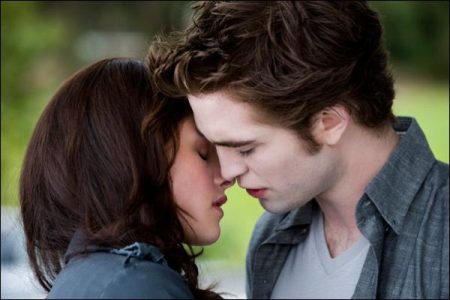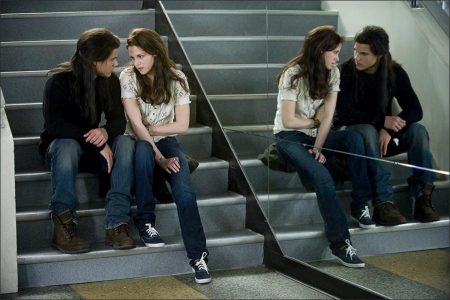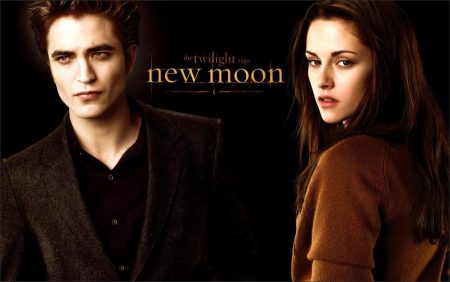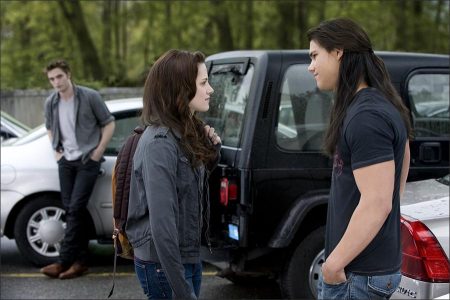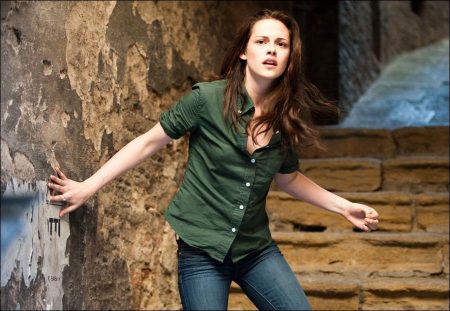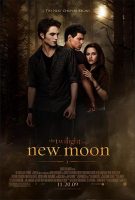All About The Twilight Saga: New Moon
The Twilight Saga: New Moon Movie Trailer. Twilight made international superstars out of its young leads: Kristen Stewart, who plays Bella Swan, the innocent mortal at the tale’s heart, and Robert Pattinson, who plays Edward, Twilight’s seductive and conflicted vampire heartthrob. Now, The Twilight Saga: New Moon positions Taylor Lautner to join them as he reprises his role as Jacob Black, who has literally become an unstoppable force of nature.
Director Chris Weitz came to the project in the unusual situation of knowing who his leading actors would be. “I usually get quite aggressive about casting,” he says. “In this case, I had the good fortune of inheriting this great group of actors that Catherine Hardwicke cast in the first place. The chance to work with them was one of the most exciting parts of the experience.”
But not all of the cast members were in place when Weitz sat down in the director’s chair. “There are a few new characters who are on screen for a relatively short time but have incredible impact and punch, and lead into the mythology of the rest of the series,” says Weitz. “I always try to get just the right people no matter what size the role is.”
At the beginning of filming, Weitz did something he’d never done before: He distributed a 20-page pamphlet outlining his ideas for the film and the characters. “I called it an orientation guide,” he explains. “The information I gave them was meant to acquaint them with the settings and the style of the movie, so that they knew as much as possible beforehand. That gave us the freedom to improvise on the day. I never want to lock young actors and creative people into decisions that I’ve made, but I like to give them as much to go on as possible.”
Bella, Edward and Jacob: An Eternal Triangle
The film’s opening moments are spent with Bella, who is becoming more aware of her age and mortality. “It’s weighing on her very heavily,” says Kristen Stewart. “Her biggest nightmare is that Edward will leave her. And he does. Anybody who’s ever been broken up with or had their heart stepped on knows that you question everything. It’s like, I was so sure of this, and now is anything that I thought about real? Because nothing could be more real than that, and I was wrong.”
Stewart wants to be clear: Bella is not the damsel in distress. “She’s very much in control of her own situation. She gave herself to someone, and in return expected the same from him.”
Bella has developed two strong, but different relationships with the men in her life. “Edward is something she needs,” says the actress. “He balances her, but that doesn’t mean that he’s the best person for her. He’s difficult, he’s cold, he reserved.
“Jacob is the polar opposite,” Stewart continues. “He’s light. He’s fun and warm, and brings the best things out of her. Basically he’s her best friend, and if you could date your best friend it would be a beautiful thing, but you’re not always in love with them.”
Weitz’s level of preparation won big points with Stewart. “Chris has very organized thoughts and he’s really collaborative,” she says. “It was good to know he was as committed to the project as we are, not just jumping on the next big thing.”
Robert Pattinson was also impressed by the director’s grasp of the world of Twilight. “Twilight had a happy ending,” the actor says. “Bella and Edward were together and they’d vanquished their enemies. In The Twilight Saga: New Moon, reality sets in. They are dealing with the progression of their relationship and commitment to each other, as well as the very real threats coming out of it. When Edward leaves Bella, he basically takes her life from her, and he kills himself by being away from her, because they’ve become so dependent on each other.
“Because Kristen and I have played the parts before, we have a very specific idea of how we think the characters develop throughout the whole series,” Pattinson continues. “Chris was very understanding of that. But he also came prepared with a lot of great ideas and he had a lot of research to back them.”
Pattinson refers to his character as a “reluctant vampire,” in contrast to the Volturi. “They see themselves as monsters, but they’re comfortable with that,” he says. “But when they see a human who says she loves Edward, they want to believe that can happen, and that’s what saves him.”
The Twilight Saga: New Moon signals the rise of Jacob Black, a character that plays a more peripheral role in the first film. Jacob is a member of the Quileute tribe, the traditional people of Forks, Washington. A childhood friend of Bella’s, Jacob was not initially meant to be as integral to the story as he became, according to Meyer. “Jacob came out of nowhere. He wasn’t supposed to exist in the way that he does, but his personality was so there and so strong. I could see how he would shape the events of the book.”
During The Twilight Saga: New Moon, Jacob learns he has been chosen to become a protector of his people-a werewolf who defends them against the predations of the vampires. “Jacob’s been going through a transformation,” Lautner says. “You’ll see a different physicality in Jacob’s character. And as he becomes different physically, he changes emotionally.
“I enjoyed doing the majority of my own stunts and those are some of my favorite moments in the film,” says the actor, who was 17 during principal photography. “For instance, in one scene, Jacob rips out of the house, jumps over a fence, hops across a creek and sprints through a field. I was on wires and got lifted ten feet above the ground until coming to a jolting stop where I had to freeze so the visual effects people could later take my body and convert it into a wolf.”
Lautner, who played sports all through school and competed in “extreme martial arts,” says his athleticism not only allowed him to accomplish his stunts, it also informed the mannerisms and progression of the character. “Pre-transformation, he’s very clumsy, like that enthusiastic teenage boy who jogs around, tripping over his own feet,” the actor says. “But when he goes through his wolf evolution, he becomes very agile,”
Jacob’s relationship with Bella is changing also. “The opportunity that Jacob has to develop his relationship with Bella is the most exciting change for me,” says Lautner. “Jacob becomes the sunshine that wakes Bella up and brings her back to life. And then when Edward comes back, Jacob loses all that.”
The Internet has spawned a robust Team Jacob versus Team Edward debate. “Taylor does a lot for Team Jacob,” says Meyer. “The whole Team Jacob/Team Edward thing is based on the type of boy that an individual is interested in. If I were for a team, I’d say I’d probably be Team Jacob. That’s more my style. If you believe that you can develop a deep friendship and then all of a sudden fall in love later on, then you should be Team Jacob. But if you believe in love at first sight and seeing that mysterious man in the corner, then all right, join Team Edward.”
Vampires and Volturi
In a brief but pivotal appearance, the vampiric Cullen family hosts a birthday party for Bella where a paper cut sets off a dangerous chain reaction, prompting Edward to end the romance. Ashley Greene, Peter Facinelli, Elizabeth Reaser, Nikki Reed, Kellan Lutz and Jackson Rathbone all return as the Cullen family.
“We’ve turned into a real family,” says Reed. “We are all so passionate about this and my castmates are such smart, interesting people. It’s great to work with them again and we are so fortunate that we get to carry these characters through multiple films. We are all such fans of the books, it’s been extremely gratifying to bring something to life that we love so much.”
Alice Cullen, played by Greene, comes into her own in this chapter of the story. Her visions of the future lead directly to Bella’s desperate attempts to rescue Edward from his misguided attempt to kill himself.
“Bella is essentially Alice’s best friend,” says Greene. “She wants what is best for Bella. To Alice, the most logical thing is for Bella to become a vampire and stay with the Cullens. She’s respectful of Edward’s desire to let Bella remain a human for as long as possible, but Alice has seen a different kind of future.”
Two elements of Alice particularly delighted Greene-her penchants for beautiful clothes and fast cars. “I got to wear the best costumes,” she says. “Tish Monaghan, the costume designer, found these great jackets-a white silk trench coat, a striped Michael Kors jacket- and paired them with black tights and flat ballet shoes and long red gloves. They were great and so Alice-quirky. I also got to drive this amazing yellow Porsche through these windy streets in Italy. I only had one driving lesson the day before we were supposed to film it. I have to say, I almost nicked a couple buildings!”
The Twilight Saga: New Moon marks the first appearance of the Volturi, the closest the vampire world has to royalty and a major force in the future of the saga. Centuries old and unimaginably powerful, they serve as lawmakers and enforcers for the community. The leader of the group is Aro, played by Michael Sheen. Sheen is no stranger to this world, having played a werewolf enslaved by the vampires in the Underworld series. But Sheen says there was another on the set who embodied both vampire and werewolf.
“Chris Weitz looks like a cross between a vampire and a werewolf to me,” says the actor. ‘He’s got the chiseled look of a vampire, and yet he is buff like a werewolf, so he was like a great mythological creature going around the set. ”
Sheen developed a distinct vocalization for Aro, higher pitched and more precise than his normal speaking voice. Weitz notes that his intonation perhaps arose from their early talks about the character. “Essentially, the character is 2,000 years old,” says Weitz. “English is not his first language, so he might speak it in a calculated way. He is incredibly gracious and endearing, but also extraordinarily dangerous.”
In fact, Sheen says, he unconsciously channeled the scary, psychedelic, music-hating, color-sapping Blue Meanies of Yellow Submarine fame when voicing Aro. “There was a moment where I suddenly thought, ‘Oh, I sound a little bit like the Blue Meanies,'” he says. “I found them really disturbing when I was a kid, so I thought that was a good thing.”
While all the Volturi are formidable, perhaps the most fearsome is Jane, a sweet-faced, innocent-looking vampire who can-and does-inflict pain merely by willing it. She is played by Dakota Fanning.
“I’ve never really gotten to play a bad guy before, but in this one, I play a bad girl -or vampire-and it was really fun,” Fanning says. “Plus, I was a really big fan of the books, I read all four of them in about a week, so it was thrilling to be asked to be a part of the film.”
The Wolf Pack
The Cullens are a family; the Volturi are a completely different kind of family-and then there are the werewolves, who Chris Weitz describes as more of a fraternity. “Not in the sense of like Alpha Omega Chi,” says the director. “They are a band of brothers whose job it is to protect their land and their tribe and even the people around them who don’t necessarily understand what they’re doing.”
In the story, the Quileute wolf pack evolved as protection against the vampires. The werewolf trait is dormant until tribal land is threatened, and then those chosen by fate for this role have no choice and little control over the transformation. The real-life Quileute have no tradition of lycanthropy, but according to legend, the tribe is descended from wolves that were changed into men. Even the tribal name “Quileute” comes from their word for wolf, “Kwoli.”
Chaske Spencer plays Sam Uley, the serene, self-assured leader of the pack. He took the lead on the set as well, earning the nickname “Alpha” from his fellow actors. “As Sam, I felt like I had to take care of my boys,” Spencer explains. “It was easy-we liked hanging out with each other on and off screen, and we really got into the characters. It was a real brotherhood.”
Sam was the first young man of his generation to experience the transformation and he has had to guide the ones who followed. “His priority is to protect his people,” says Spencer. “That’s his job. It’s not a job I think he really wanted, but it’s what he’s been chosen for.”
All the actors playing wolf pack members are of Native American descent. Spencer is Lakota (Sioux); Bronson Pelletier, who plays Jared, is Cree-Metis; Kiowa Gordon, who plays Embry Call, is Hualapai; Tyson Houseman, who plays Quill Ateara, is Cree; and Alex Meraz, who plays Paul, is Purepecha (Tarasco).
Meraz’s heritage played a key role in his characterization of Paul. “In the wolf pack, you see a little bit of what it’s like to be native people on a reservation, especially the sense that the indigenous community regards itself as a family, the way the wolf pack does,” says Meraz.
“My tribe is from Mexico, and my grandfather was a shaman there,” he goes on. “Our people were fishermen, like the Quileutes. In preparation for my audition, I prayed and asked for permission to portray this tribe. You have to pay respect to the people from the past, the present and the future.”
To get into fighting trim, the actors went through “wolf camp” and trained hard throughout filming. “They brought a lot of energy to the set,” says Kristen Stewart. “They were always working out and practicing wolf cries. It brought a new energy to the movie. They’re warm and fun and frisky. They’re also full of life in a way the vampires aren’t.”
Making New Moon Shine
The Twilight Saga: New Moon began shooting in March 2009 in Vancouver and ended in Montepulciano, an ancient walled city in Italy. The two cities provided a strong contrast-the dark nights and mysterious, deep green forests of British Columbia, and the organic, burnished tones of Tuscany inform the film’s look equally.
“The light in the Pacific Northwest provides a great deal of diffusion and coolness,” Chris Weitz says. “Within that, there are plenty of beautiful colors, and our intention was to use the lion’s share of them. Shadows are also important -the forest at night, the blackness of depression.
“The light is much different in Tuscany,” Weitz notes. “It has much warmer tones and is literally much sunnier, with pops of color from the costumes. The architecture is different as well. Montepulciano is known for its Renaissance architecture, with remnants of medieval architecture as well.”
Production designer David Brisbin worked closely with Weitz to establish the film’s signature palette. “Chris came to the table with some very specific conceptions about what he wanted the palette to be like,” says Brisbin. “It revolved around pre-Raphaelite paintings, which emphasize saturated colors in natural settings.”
“I love classic, wide-screen epics like Dr. Zhivago and Barry Lyndon,” says Weitz. “I was also thinking about what sorts of paintings made sense for this world. For me, it was narrative painting and pre-Raphaelite works. They share a very strong emphasis on story, on sentiment, on love and loss, heartbreak and longing. These are the paintings that accompanied Tennyson and that whole era of sentimentality. They also revived a jewel-toned palette and treatment of color that made sense to me, that was going to be different from the first movie but would be faithful to the spirit of the second book,” Weitz says.
Brisbin’s eclectic résumé proves him to be something of a Renaissance man himself, uniquely qualified for his task. As a young man, Brisbin received a Henry Luce Scholars Grant to study in Asia and worked as a TV reporter, covering the fall of the Marcos regime in the Philippines. Initially trained as an architect, he interned under renowned American architect Robert Venturi, who famously turned Mies van der Rohe’s maxim on its head by stating, “Less is bore.”
“At its heart, this film is about romance,” says Brisbin. “Yes, it’s a vampire movie, but it’s really a love story. The whole idea of production design for me is absolutely rooted in storytelling. What I care about is that the drama the actors and the director are trying to assemble in front of the lens is cradled in an environment that’s perfect for the story being told.”
In Meyer’s book, the Volturi reside in the ancient Italian city of Volterra, a real location in Tuscany. “The choice of Montepulciano as our Volterra was a big discussion,” Brisbin says. “Chris wanted architectural antiquity to guide us in making the world of Volterra. Montepulciano is in fact a medieval city, and the piazza and the city hall there gave him an access that would allow him to do a symmetrical shot. And that quite specifically was the reason we ended up in Montepulciano.”
Meyer’s descriptions of Volterra and the Volturi stronghold provided a solid blueprint for Brisbin to work with. “If there’s such a thing as fiction writing for production design, Stephenie Meyer’s Volterra is a very successful example of it,” he notes. “She imagined a world in which the architecture contributes to the story.
“The Volturi hold court in a circular hall almost like a vortex. It has a drain in the middle, which is where the blood goes if the most dangerous thing happens,” he says. “She envisioned an endless corridor, which we were able to create without too much effort using CG technology. These are spaces that are designed to reflect one’s position in the world, and one’s experience as one moves through the world.”
The production designer borrowed liberally from well-known examples of Tuscan architecture. “We haven’t matched any particular piece of architecture exactly, but we use a motif of the green stripes that are drawn from the green and white marble used in various Tuscan cathedrals and churches. There is an exuberance in medieval and Renaissance architecture in Tuscany that is followed up with a kind of excessive nouveau riche architecture in subsequent years, and that provided us with very, very rich inspiration.”
Costume designer Tish Monaghan was tasked with complementing the sets with a refined and elaborate wardrobe for the Volturi, whose look literally spanned centuries. “The key point that Chris wanted to impart was that the Volturi were very elegant,” says Monaghan. “We looked to the 1700s and chose a silhouette that developed roughly around 1790-a long, lean look.
“We wanted to operate within the specific color palette David and Chris developed, but it changed between the 18th century and the 21st century. The characters meet in the 21st century, but we also see them in flashback in the 18th century. In the 21st century we tried to make them as dark as possible, with the character Aro being the darkest of all, because he has the most power. And in the 1790s, I did the reverse, and I tried to make Aro as light as possible, because then we could see him at the top point of that triangular color palette where he would naturally take focus, while the others would resemble his courtiers.”
While the exotic cult of the Volturi is recreated through an Old World, handcrafted process, their nemeses, the werewolves of the ancient Quileute tribe, are represented on screen through cutting-edge 21st century technology. “One of the most important additions to the world of New Moon is the CG characters,” says producer Wyck Godfrey. CG was the only way we could accomplish the horse-sized wolves Stephenie described in her books.”
Weitz brought in effects supervisor Susan MacLeod, with whom he had worked on The Golden Compass. “We got along really well,” she says. “When he asked me if I was interested in this project, I was on board from the word go. The wolves are probably the sexiest things in the script.”
Tippett Studio, founded by visual effects pioneer Phil Tippett, created the wolves for The Twilight Saga: New Moon. “We were excited to be able to establish what they will look like for the whole saga,” says MacLeod. “We tried to stay very true to the descriptions in the book. Even though they’re discussed as werewolves, they’re not the stereotypical bipedal creatures that start bursting hair out of their fingertips and faces. They’re very elegantly transitioned from human beings to wolves with four legs.
“Everyone who read the book and fell in love with Team Jacob is dying to see how we’ve done it,” MacLeod continues. “It’s not animation-they look like real wolves. We started by CG-scanning the actors into the computer prior to principal photography so we could transform them into wolves in mid-shot.”
The scanning process proved surprisingly simple-for the actors, at least. “I was expecting to be in a green suit, with little pins everywhere,” says Alex Meraz, who plays the character of Paul. “They just had me stand on an apple box, and this big machine just came up, over and down. And that was it.
“I could watch on the monitor and my body was right there on screen, a perfect scan of it. I was blown away how quick it was. The best way to describe the transformation is like popcorn. The image just pops and there’s the wolf.”
But that was just the beginning for the effects team. “We built the wolves from the inside out in the computer,” explains MacLeod. “So we started with a skeletal system with moving joints that can be animated. And on top of that, we laid muscles that can flex. And then a layer of skin and fur. We wanted them to look and act like real wolves without any sort of anthropomorphic quality.
“The guys at Tippett Studio actually went to a wolf preserve,” she says. “They shot lots of video of them, as well as referencing everything they found on the Internet. Wolves are fascinating animals, so it’s quite easy to watch hours of footage of them.”
To give the actors a point of reference during shooting, the filmmaker used wolf stand-ins that come in all different shapes and sizes. “Some of them were stuffed, three dimensional figures,” says MacLeod. “Others were full-size cut-outs that were more durable and could be posed to line up the shots accurately. Then we could shoot a template for the animators to use for positioning the wolves. We also used fur pelts, because we wanted to light the CG wolves so that they fit into the plate seamlessly.”
Twilight was shot primarily on location in Portland, Oregon, but for The Twilight Saga: New Moon, the filmmakers moved further north to Vancouver, British Columbia. “I think it was important for the studio and important for the fans that this stage of Bella’s life have a good correspondence to the first stage of Bella’s life as they know it,” says production designer Brisbin. “For Bella’s house, that meant we had to build the interior and the exterior to match the first part of the movie. We looked obsessively at the original location and studied the footage from the first film very, very carefully.”
In some cases, however, the design team decided to change certain architectural elements for specific story reasons. “In the first house,” he says, “if you look very, very carefully, there’s a flicker of a moment when you can see actually the side of the house, and there’s no bay window there. But there’s this enormous sequence where Jacob leaps “parcours”-style into her window, and it’s one of the most important scenes between them. For that, it was worth it to deviate from the old diagram to support the storytelling.”
The Cullen house provided a different challenge. “In the first film you actually do see the exterior of the Cullens’ home clearly,” says Brisbin. “You see the front stairwell. You see connecting rooms. You see Edward’s room, and you also see the kitchen. Most of our work was in other parts of the house, creating additional rooms that fit into what we already knew like pieces in a jigsaw puzzle.”
The production designer’s final assignment was to realize the two homes around which the wolf pack’s lives revolve. “Jacob’s house and Emily’s house did not exist in Twilight,” he continues. “We looked very carefully at the book and debated intensely what we could deviate from. Jacob’s house is described as a red house. We found this fantastic location that was connected to the forest in a way that implied wolf life behind the trees. Everything seemed perfect.”
Except for one thing. The house was green. “It was important to us to keep the red of Jacob’s house,” according to Brisbin. “We knew it as a red place from the book, and we wanted that. So we ended up painting the whole place red to match the book.”
The house in which Emily, Sam Uley’s girlfriend, lives was designed to reflect Weitz’s interpretation of her character, says Brisbin. “He felt that Emily represented solace in the world of the wolf pack. They’re dynamic, they’re crazy, they run around, and change back and forth. But there is this anchoring place that is centered and thoughtful. We were looking for a secret forest place that carried this sort of wispy feminine lightness.
“The fellow who owned the house we used built it when he was 17, and I think some of its sort of sylvan majesty comes from the fact that it really is a place that a 17-year-old kid built as his ideal cabin,” Brisbin continues. “I believe fairly soon after he built it, he married the woman he still is married to today. It was their house for a very long time. They eventually outgrew the house, but it was traumatically difficult for either husband or wife to agree to leave this place, because it is just so magical.”
That attention to detail and faithfulness to the letter and spirit of Stephenie Meyer’s Twilight series informed the entire production process, says Weitz. “If you loved the characters and the romance of Twilight, if you love the supernatural, The Twilight Saga: New Moon has that and it has more. It expands that world to include the larger mythology that will eventually provide the bridge between Twilight and the third chapter, The Twilight Saga: Eclipse.”
The Twilight Saga: New Moon (2009)
Directed by: Chris Weitz
Starring by: Kristen Stewart, Robert Pattinson, Taylor Lautner, Ashley Greene, Peter Facinelli, Elizabeth Reaser, Kellan Lutz, Nikki Reed, Jackson Rathbone, Edi Gathegi, Rachelle Lafevre
Screenplay: Melissa Rosenberg
Production Design by: David Brisbin
Cinematography by: Javier Aguirresarobe
Film Editing by: Peter Lambert
Costume Design by: Tish Monaghan
Set Decoration by: Lesley Beale
Art Direction by: Catherine Ircha
Music by: Alexandre Desplat
MPAA Rating: PG-13 for some violence and action.
Distributed by: Summit Entertainment
Release Date: November 20, 2009
Views: 112
